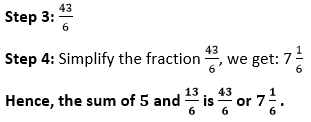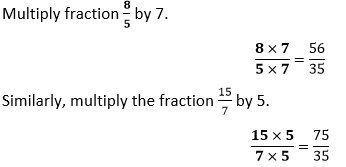Adding Fractions
In this section, we will learn what is fraction, its representation, types of fractions, and how to add improper and mixed fractions in both cases:
- When the denominator of each fraction is the same
- When the denominator of each fraction is unlike (not same)
Fraction
In mathematics, fraction represents a number. A number that is in the form of numerator and denominator, is called a fraction. It is represented by 
The numerator tells the number of equal parts taken, and the denominator tells the total number of equal parts in the whole collection.
In general, we can say that it is:

Types of Fractions
There are two types of fractions, improper and mixed.
Improper Fraction
It contains the only fraction. We normally use the improper form to represent a fraction. Let’s understand through the examples.

In the above figure, there are two circles. First circle is divided into four equal parts that represents the whole circle. In the figure (b), we have cut a part from the circle. Now, what if want to represent that circle in the in the form of number? Here, the concept of fraction applies. We can represent it in the fractional form that is 
Mixed Fraction
It is a combination of whole number and improper fraction. In general, we can write it as 
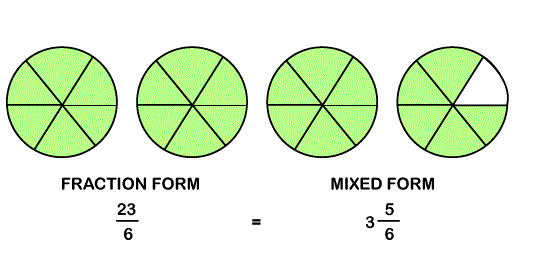
In the above figure, there are four circles that are equally divided into six equal parts, except for the last circle. If we add all the colored parts of all the circles, we get 23 (6+6+6+5). Now, the question arises that how to represent it in the form of the number.
We can represent it in the mixed form as 

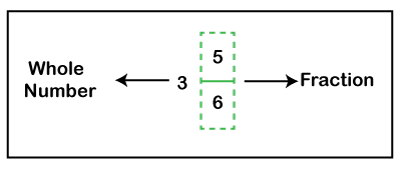
We can also represent the mixed fraction into improper fraction without changing its value. It means that we can represent 
Now, we will learn how to add fractions.
How to Add Fractions
Addition of Improper Fractions
When the denominator of each fraction is the same:
- Add the numerators, and put resultant in the answer.
- Simplify the fraction if required.
In general, we can say that if 

Remember: To simplify a fraction, numerator and denominator must be divisible by the same number.
Example 1: Find the sum of 
Solution:

On simplifying the fraction 
Hence, the sum of 
Example 2: Add the fractions 
Solution:

Hence, the addition of 
Example 3: Add the fractions 
Solution:

On simplifying, the fraction
Hence, the addition of 
When the denominator of each fraction is unlike (not similar):
- Find the LCM of the denominators because we need to make denominator the same.
- Divide the LCM by the denominators.
- Multiply the resultant in the numerators, respectively, and simplify.
- Add numerators, and get the answer.
In general, we can say that if 

Example 4: 
Solution:
Let’s solve the question according to the above steps.
Find the LCM of the denominators.
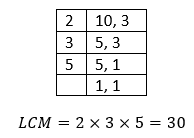
Divide the LCM by the denominators.

Multiply the resultant (from the above step) in the numerators, respectively and simplify.
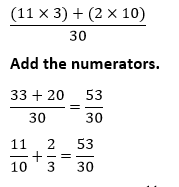

Solution:
- Find the LCM of the denominators.
Multiple of 5 are: 5, 10, 15, 20, 25, 30, 35
Multiple of 7 are: 7, 14, 21, 28, 35
35 is common in both, so the LCM is 35. Put this 35 as denominator in the answer. - Multiply the numerator and denominator to get like denominators.
Now, both fractions have the same denominator. - Add the new fraction’s numerator and put the answer over the denominator that we have got in the first step.
Addition of Mixed Fractions
When the denominator of each fraction is the same:
- Add the whole numbers, separately.
- Add the numerators, separately.
- Keep the denominator the same.
- Write the result in the mixed form or improper form.
- Simplify the fraction, if needed.
Example 6: Add and 
Solution:
Step 1: Add the whole numbers, i.e.
Step 2: Add the numerators, i.e.
Step 3: No change in the denominator because both are same.
Step 4: Write the result:
Step 5: Simplify the fraction. On dividing the fraction 


When the denominator of each fraction is unlike (not similar):
- Change the mixed fraction into improper fraction.
- Find the LCM of the denominators.
- Multiply the numerator and denominator to get like denominators.
- Add the new fraction’s numerator.
- Simplify the fraction, if required.
Example 7: Add and 
Solution:
Step 1: Convert each mixed fraction into an improper fraction.

Step 2: Find the LCM of the denominators.
Multiple of 3 are: 3, 9
Multiple of 9 are: 9
9 is common in both. So, the LCM is 9.
Step 3: Multiply the numerator and denominator.
The LCM is 9, and the fraction 


Step 4: Add the numerators.

Step 5: Simplify the fraction
On dividing the above fraction by 9, we get the mixed fraction

Let’s see some other examples.
Example 8: Add 5 and 
Solution:
In this example, 5 is not a fraction. When a number is not in fraction consider its denominator as 1 i.e.,
- Multiply the denominator by the non-fractional number.
- In the resultant, add the numerator and put it as numerator in the answer.
- Keep the denominator same.
- Simplify the fraction, if required.
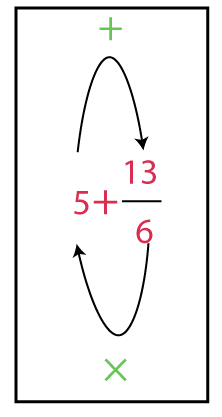
Step 1: 6×5=30
Step 2: 30+13=43
